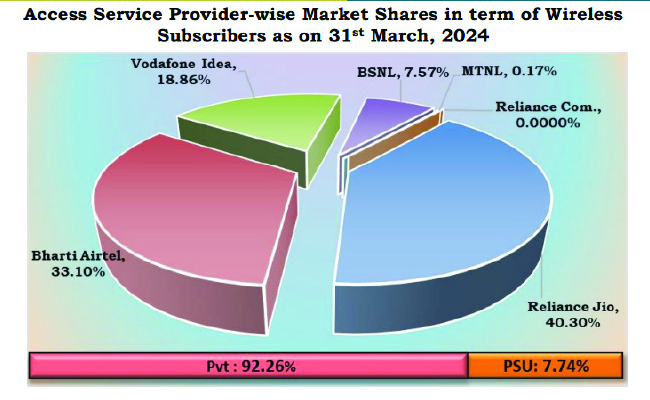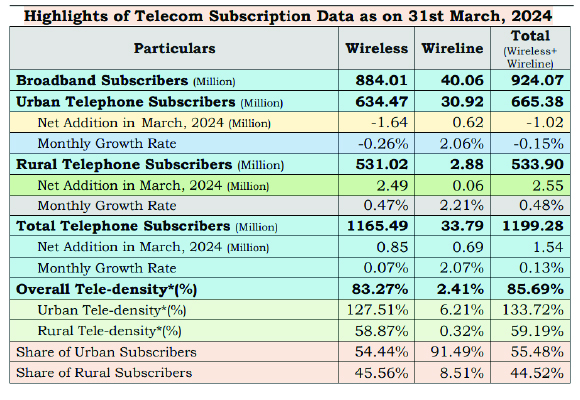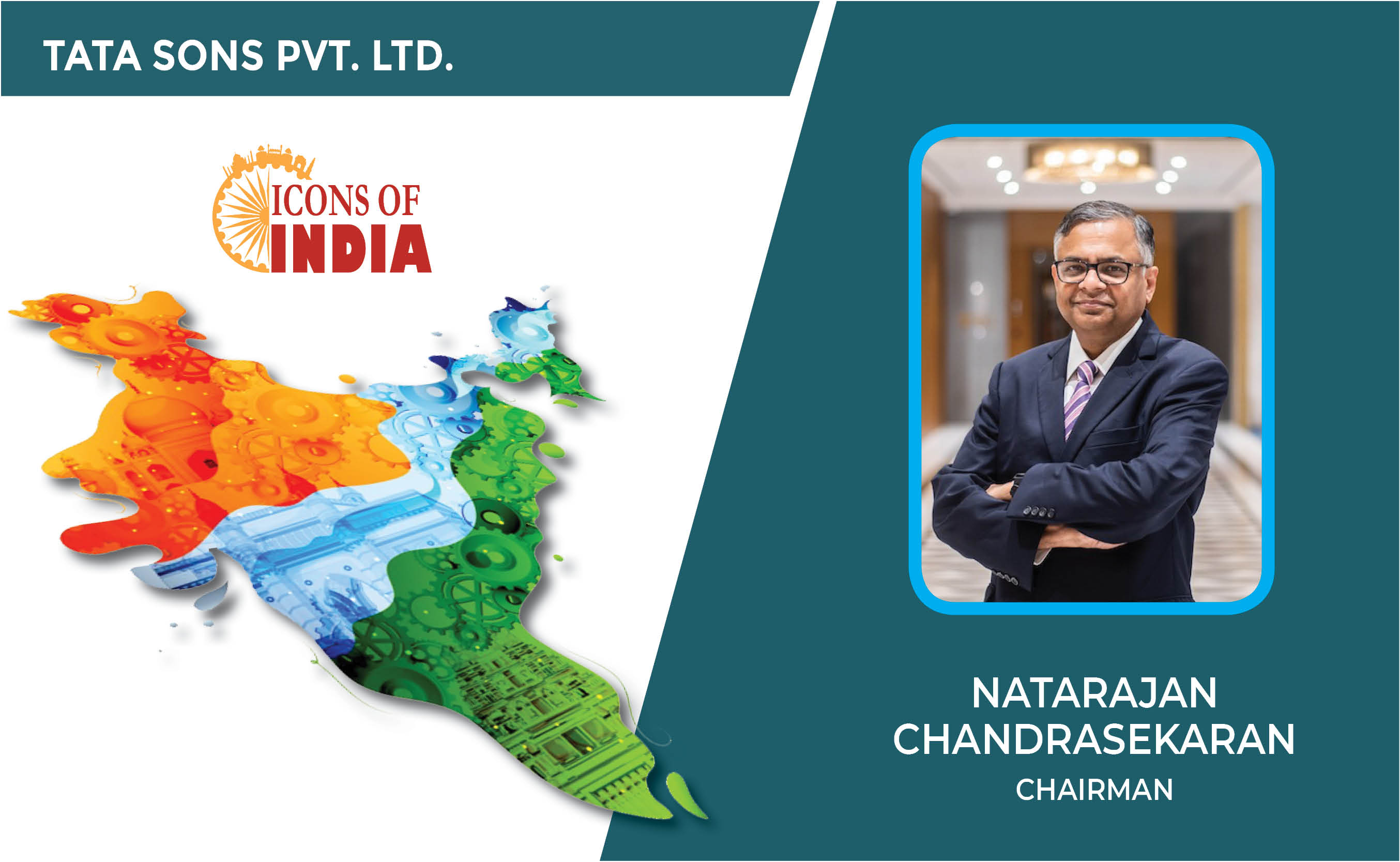Telecom Industry : A Year of Growth and Transformation
By MYBRANDBOOK

The Indian telecom industry, recognized as one of the fastest-growing telecom markets globally, serves as a pivotal element in India’s digital revolution and economic development. With its vast subscriber base and continuous technological advancements, the sector plays a crucial role in connecting people, fostering innovation, and driving economic growth. The industry’s evolution over the years has been marked by significant milestones, including the proliferation of mobile connectivity, the advent of 4G services, and the ongoing deployment of 5G technology.
In 2023, the Indian telecom industry navigated through a landscape of rapid technological changes, competitive dynamics, and evolving consumer demands. This year saw a substantial increase in subscriber numbers, enhanced revenue streams, and several key developments among major telecom service providers. The sector’s resilience and adaptability were evident as it continued to expand its reach and improve service quality despite facing challenges such as regulatory pressures, financial stress, and the need for substantial capital investments in new technologies.
The competitive landscape was primarily dominated by three major players: Reliance Jio, Bharti Airtel, and Vodafone Idea. Each of these telecom giants undertook strategic initiatives to solidify their market positions, enhance network capabilities, and introduce innovative services to meet the growing demand for high-speed connectivity and digital services. The year was also marked by significant policy reforms by the Indian government, aimed at providing financial relief to telecom operators and encouraging investments in infrastructure and technology.
Moreover, the increased adoption of digital services, driven by the surge in data consumption due to remote work, online education, and entertainment, highlighted the sector’s critical role in supporting the digital ecosystem. As the industry embraced new technologies and expanded its service offerings, it also faced the challenge of ensuring affordability and accessibility for all segments of the population, particularly in rural and underserved areas.
The Market
The Indian telecom sector saw substantial growth in 2023, building on the momentum from 2022. According to data from the Telecom Regulatory Authority of India (TRAI), the number of telecom subscribers increased from 1.15 billion in December 2022 to 1.19 billion by March 2024. This growth was primarily driven by rural expansion and the increasing affordability of smartphones and data plans.
The subscriber base expanded due to several factors, including aggressive marketing campaigns, attractive data packages, and the widespread availability of low-cost smartphones. Rural areas, which had previously lagged in telecom penetration, saw significant uptake due to government initiatives and infrastructure investments by telecom companies. The rural subscriber base grew by 5% year-on-year, compared to a 2% growth in urban areas.
Top five service providers constituted 98.36% market share of the total broadband subscribers at the end of March-24. These service providers were Reliance Jio with 481.07 million, Bharti Airtel 273.23 million, Vodafone Idea 127.69 million, BSNL 24.70 million and Atria Convergence with 2.25 million subscribers.
Revenue for the industry also saw a notable increase. The gross revenue of the telecom sector grew from INR 2.65 trillion in 2022 to INR 2.85 trillion in 2023, marking an 8% growth. This increase was driven by higher data consumption, with average revenue per user (ARPU) rising from INR 144 in 2022 to INR 158 in 2023. The surge in data usage was propelled by the proliferation of video streaming services, online education, and remote working trends.
As on 31st March, 2024, the private telecom operators held 92.26% market share of the wireless subscribers whereas BSNL and MTNL, the two PSU access service providers, had a market share of only 7.74%.
The Players
2023 was a year of significant developments for major telecom service providers in India. Each of the top players—Reliance Jio, Bharti Airtel, and Vodafone Idea—undertook strategic initiatives to strengthen their market positions and enhance service offerings.
Reliance Jio
Reliance Jio continued to dominate the market with its aggressive expansion and innovation strategies. In 2023, Jio launched its 5G services in major metropolitan areas, marking a pivotal moment in India’s telecom landscape. The rollout of 5G was accompanied by the introduction of affordable 5G-enabled smartphones, which further accelerated subscriber growth.
Jio’s focus on digital services, including JioMart, JioTV, and JioSaavn, contributed significantly to its revenue growth. The company reported a 10% increase in its subscriber base and a corresponding rise in ARPU.
Bharti Airtel
Bharti Airtel maintained its competitive edge through strategic investments in network infrastructure and customer service. Airtel’s 5G services were launched in several key cities, with plans for nationwide coverage by the end of 2024. The company’s “Project Leap,” aimed at network expansion and quality improvement, saw an investment of INR 200 billion in 2023.
Airtel’s ARPU increased by 12%, driven by higher data usage and premium service offerings. The company also focused on expanding its Airtel Xstream fiber broadband services, which saw a 25% increase in subscribers. Airtel’s digital platforms, such as Airtel Thanks, Wynk Music, and Airtel Payments Bank, played a crucial role in enhancing customer engagement and revenue diversification.
Vodafone Idea
Vodafone Idea faced significant challenges in 2023, including financial stress and intense competition. Despite these hurdles, the company managed to stabilize its operations and focus on network improvement. Vodafone Idea launched its 5G services in select cities and invested in upgrading its existing 4G infrastructure to enhance service quality.
The company’s subscriber base remained stable, but it struggled with declining ARPU, which stood at INR 129 in 2023. Vodafone Idea’s strategic focus on cost optimization and partnerships, such as its collaboration with Google Cloud for digital transformation, aimed at long-term sustainability.
BSNL
By the end of March 2024, the wireless subscriber base of the state run telecom operator BSNL has reduced to 88 million despite being a pan-India player. It has 24.7 million broadband users, of which 4 million are wired broadband users while the rest 20.7 million are wireless broadband users. Once a leader among the wireline service providers, BSNL also has reduced to the number 3 player in that category with only 6.5 million subscribers out of India’s total 33.8 million wireline or landline user base.
The company is currently rolling out is 4G services using telecom gears from ITI and TCS. In August 2023, Tejas Networks won a Rs 7492 crore contract to supply 4G/5G RAN for BSNL’s pan-India network.
Till December 2023, the company’s revenue rose 1.2% to touch Rs 12,915 crore.
Major Announcements and Strategic Initiatives
2023 witnessed several major announcements and strategic initiatives from the Indian telecom sector. These included mergers, acquisitions, partnerships, and policy reforms that shaped the industry’s trajectory.
One of the most notable developments was the acquisition of a significant stake in Vodafone Idea by a consortium led by Aditya Birla Group and Vodafone Group. This infusion of capital aimed to reduce the company’s debt burden and fund its 5G expansion plans. The acquisition was seen as a crucial step towards stabilizing Vodafone Idea and ensuring its competitive presence in the market.
Strategic partnerships were another highlight of 2023. Reliance Jio partnered with global tech giants like Google and Facebook to develop innovative digital services and enhance user experience. Bharti Airtel collaborated with Ericsson and Nokia for its 5G network deployment, leveraging their expertise to ensure a robust and efficient rollout.
The Indian government introduced several policy reforms to support the telecom sector’s growth. The reduction of license fees and spectrum usage charges, along with the extension of the moratorium on adjusted gross revenue (AGR) payments, provided much-needed relief to telecom operators. These reforms aimed to improve the financial health of the industry and encourage further investments in infrastructure and technology.
 Outlook for 2024
Outlook for 2024
Looking ahead, the Indian telecom industry is poised for continued growth and transformation in 2024. Several key trends and developments are expected to shape the industry’s future.
The full-scale rollout of 5G services across India will be a major focus in 2024. Telecom operators are expected to invest heavily in network infrastructure to ensure widespread coverage and seamless connectivity. The adoption of 5G is anticipated to drive significant growth in data consumption and enable new applications in areas such as IoT, smart cities, and industrial automation.
Digital services and content delivery will continue to be a crucial growth area for telecom operators. The increasing demand for online entertainment, remote education, and digital payments will drive higher data usage and ARPU. Telecom companies will likely invest in developing and expanding their digital ecosystems to offer a comprehensive suite of services to consumers.
Improving financial health remains a priority for the industry, particularly for players like Vodafone Idea. Strategic investments, cost optimization, and policy support will be essential to ensure sustainability and competitiveness. The industry may also witness further consolidation, with potential mergers and acquisitions aimed at achieving economies of scale and operational efficiencies.
The regulatory environment will play a significant role in shaping the industry’s future. Continued government support through favorable policies and reforms will be critical in driving growth and innovation. The focus on improving ease of doing business, enhancing spectrum management, and promoting fair competition will be vital for the industry’s development.
Conclusion
The Indian telecom industry experienced a transformative year in 2023, marked by significant growth in subscriber numbers, revenue, and technological advancements. Major telecom service providers, including Reliance Jio, Bharti Airtel, and Vodafone Idea, undertook strategic initiatives to enhance their market positions and service offerings. Policy reforms and government support played a crucial role in sustaining the industry’s growth momentum.
As the industry moves into 2024, the focus on 5G expansion, digital services, financial health, and regulatory support will be key drivers of continued growth and innovation. The Indian telecom sector is well-positioned to play a pivotal role in the nation’s digital transformation, driving economic development and improving connectivity for millions of users.


Legal Battle Over IT Act Intensifies Amid Musk’s India Plans
The outcome of the legal dispute between X Corp and the Indian government c...

Wipro inks 10-year deal with Phoenix Group's ReAssure UK worth
The agreement, executed through Wipro and its 100% subsidiary,...

Centre announces that DPDP Rules nearing Finalisation by April
The government seeks to refine the rules for robust data protection, ensuri...

Home Ministry cracks down on PoS agents in digital arrest scam
Digital arrest scams are a growing cybercrime where victims are coerced or ...


Icons Of India : NATARAJAN CHANDRASEKARAN
Natarajan Chandrasekaran (Chandra) is the Chairman of Tata Sons, the h...

ICONS OF INDIA : SANJAY GUPTA
Sanjay Gupta is the Country Head and Vice President of Google India an...

Icons Of India : Bhavish Aggarwal
Indian entrepreneur Bhavish Aggarwal is the CEO of Ola, India’s larg...


STPI - Software Technology Parks of India
STPI promotes and facilitates the growth of the IT and ITES industry i...

NSE - National Stock Exchange
NSE is the leading stock exchange in India....

GeM - Government e Marketplace
GeM is to facilitate the procurement of goods and services by various ...


Indian Tech Talent Excelling The Tech World - AJAY BANGA, President - World Bank
Ajay Banga is an Indian-born American business executive who currently...

Indian Tech Talent Excelling The Tech World - JAYASHREE ULLAL, President and CEO - Arista Network
Jayshree V. Ullal is a British-American billionaire businesswoman, ser...

Indian Tech Talent Excelling The Tech World - ARVIND KRISHNA, CEO – IBM
Arvind Krishna, an Indian-American business executive, serves as the C...
 of images belongs to the respective copyright holders
of images belongs to the respective copyright holders